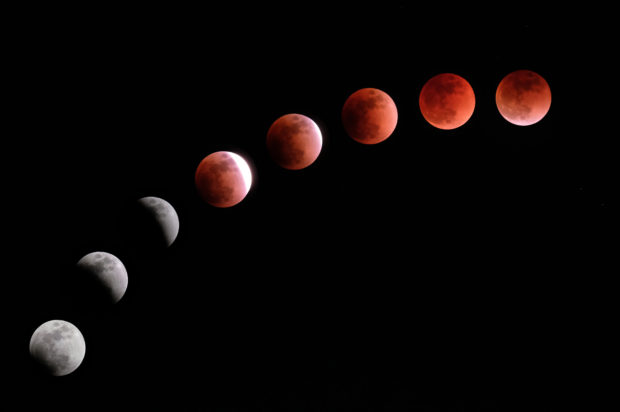
DOUBLE TREAT: This composite image created on Jan. 31 shows the moon during a lunar eclipse in Tokyo. On Friday, the longest blood moon eclipse will coincide with Mars’ closest approach to Earth in 15 years in a thrilling astronomical double bill. Image: AFP
Want to witness the total lunar eclipse that’s happening on Saturday, July 28? The Philippine Astronomical Society (PAS) can help you out.
The PAS released a list of observation sites where the eclipse can be seen best, according to the society’s Facebook post last July 12.
The society also encouraged the public to observe the “astronomical event,” as the phenomena happening this Saturday will be the longest lunar eclipse of the century, lasting one hour and 43 minutes. In the Philippines, the total eclipse will start at 3:30 a.m and end at 5:13 a.m.
However, the Philippine Atmospheric, Geophysical and Astronomical Services Association (PAG-ASA) announced that cloudy skies might affect chances of Filipinos seeing the eclipse over the weekend.
READ: Earth awaits longest blood moon
Nevertheless, here are the sites with map links as listed by the PAS, as of this writing:
QUEZON CITY Host: UP Astronomical Society Venue: PAGASA Astronomical Observatory Map: https://goo.gl/8NtNyY More details: https://goo.gl/PkMAjH open to all, walk-ins allowed ____________________________________ QUEZON CITY Host: ScienceQuest X PAS Venue: Megatent parking lot, Libis Map: https://goo.gl/Z5Nj7N open to all, walk-ins allowed ____________________________________ CAVITE Host: Astronomy and Physics Society of St. Edward Integrated Shool Venue: Backfield of SEIS- Imus Campus, Lancaster New City Cavite Map: https://goo.gl/rRBPqu open to all, walk-ins allowed ____________________________________ TAGUIG Host: Philippine Astronomical Society Venue: The Nest Food and Lifestyle Park Taguig Map: https://goo.gl/YLH5y7 open to all, walk-ins allowed ____________________________________ CEBU Host: IAU Astronomical Society Venue: IAU Arena IAU Town Center kagudoy Rd. Basak Lapu Lapu City Cebu Complete details: https://goo.gl/fYtUf3 open to all, walk-ins allowed
The total lunar eclipse will be the second this year. A lunar eclipse also happened on Jan. 31, known as the “super blue blood moon.”
Aside from the upcoming lunar eclipse, Mars will also make its closest approach with Earth. The last time this happened was in 2003, when the Earth and Mars were at their closest after 60,000 years, according to NASA. JB
RELATED STORIES:
The longest lunar eclipse of the century is expected to happen this year
Red planet and ‘blood moon’ pair up to dazzle skygazers